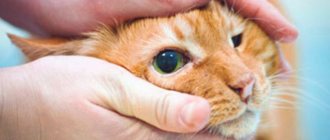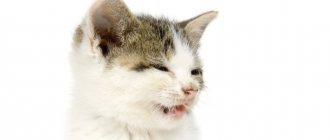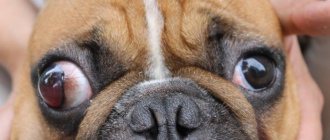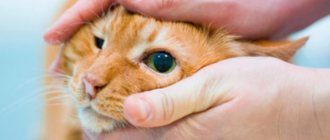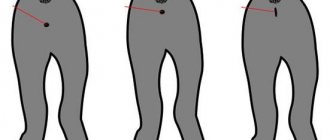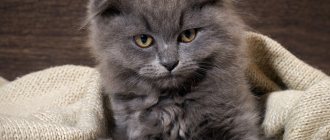- home
- Treatment
- Symptoms of cat diseases
- The kitten's eyes are watering
Inexperienced cat owners often wonder why their kitten's eyes are watering and whether this is normal. Our clinic also often receives similar complaints. However, many kittens do have watery eyes at an early age; this is a common problem in cats.
It is important to notice this in a timely manner and figure out what’s going on. The problem can develop and cause serious consequences. Therefore, it is important to eliminate it quickly.
Among other things, this causes severe discomfort in the kitten, he has to constantly squint, his eyes have difficulty seeing, you can see how the kittens try to wipe them and rub them with their paws.
Which in itself is undesirable, because this can bring dirt or foreign objects into your eyes.
Causes
The factors leading to teary eyes are varied. There are situations when it is a physiological norm.
Tears in a cat are a normal reaction of the body if:
- no swelling;
- the pupil reacts normally to light;
- the color of the discharge is transparent, without shades or impurities of pus;
- no signs of foreign objects;
- the shell has not changed color;
- the animal does not experience discomfort.
In addition, some breeds have a predisposition due to anatomical features. For example, the tear duct in the Scottish and British breeds is too short, while in the Persian it is curved. Kittens are genetically predisposed to tearfulness.
In these cases, it is enough to wipe the eyes with a sterile napkin and periodically rinse them with chamomile decoction; no additional procedures are required without changing the transparency of the tears.
Also normal is morning whitish discharge in the corners of the eyes, which is the result of the cleansing work of the lacrimal glands. The cat independently removes accumulated crusts from the eyes, but if this does not happen, the owner can help the pet with a napkin or swab soaked in saline solution or regular clean warm water.
In kittens that are just opening their eyes, increased tear production is a reaction to a physiological change that protects their delicate eyes. If the tears are transparent and not viscous, there is no reason to worry. They last no more than one week.
How to examine a cat?
Quite often, the appearance of tears in a cat's eyes indicates the presence of some kind of disease. It is important for the owner to pay attention to whether tears appeared for a limited time and then disappeared, or in the pet’s eyes the discharge is present throughout the day, or, what is much worse, not for several days.
- If the tear discharge is insignificant, appeared in the morning and quickly passed, then there is nothing to worry about, so there is no need to worry;
- If it is clear that the eyes “cry” for a long time, then you need to look for the cause of this phenomenon.
Before examining your pet, you need to clean your hands to prevent additional infection. Next, you need to pull down the upper eyelids on each eye. If the eyes are shiny and not clouded, the pupils are the same size, the cornea is noticeably transparent, and the back surface of both eyelids has a pale pink tint, then there are no problems with the animal’s eyes.
The fact that there are certain problems with the eyes can be judged by redness or swelling of the eyelids, clouding of the cornea.
If the animal’s eyes are difficult to open or there is a thin light film on the inner surface of the eyelid, then it is recommended to go to the veterinarian as soon as possible.
Pathologies
Any change in the animal's condition requires urgent contact with a veterinarian. The owner should be wary if:
- dullness and change in eye color;
- unnatural reaction of the pupil to light;
- change in the shape of the eyeball;
- the occurrence of edema;
- change in color or viscosity of the secretion,
- the appearance of purulent discharge;
- increased body temperature;
- presence of foreign bodies;
- change in color of the mucous membrane;
- runny nose;
- blood;
- strange behavior of the animal (tongue sticking out, rapid breathing, rubbing eyes).
Read the article about eye diseases in cats.
It is important to know
The decision of how and with what means to wash a cat’s eyes depends on the specific case. It is necessary to take into account the reason for which it was necessary to clean the eyes, as well as the individual reaction to any component in the composition of the drug.
If lacrimation is excessive
You can rinse your eyes with clean distilled water, but it is better with saline solution (with a salt concentration of 0.85%). This procedure will also help in removing dust, pollen, hairs and other small foreign bodies. If your pet has allergies, this method is the best.
If your eyes fester
In case of purulent exudate from the eyes or their sticking together (this happens after a while, when dry crusts appear), you need to drip the eyes with special antibacterial drugs, which are purchased at a veterinary pharmacy. This is necessary because pus is a symptom of infection.
Chlorhexidine for eye rinsing
Veterinarians do not agree on this issue, but the majority believes that it is possible. But you need to use chlorgesidine with a concentration of no more than 0.01%, then the use will be harmless.
Cleansing with furatsilin
Furacilin solution must be used with a concentration of maximum 0.02%, and the drug must also be sterile
It is important to know about possible individual intolerance to the substance; if it exists, then the use of furatsilin is prohibited
Symptoms
If a pathological cause is obvious, all manifestations of the disease should be observed to give the doctor as complete a history as possible to ensure the best decision.
Common cat diseases manifest themselves as follows:
| Symptom | Disease and cause |
| Long and profuse tearing. | Viruses and fungi such as plasmosis: calcivirosis, mycoplasmosis, toxoplasmosis, etc. |
| Pus. | Foreign objects. |
| Edema. | Turn of the century. |
| Cloudiness. | Keratitis, cataract. |
| Black spot. | Dying of the cornea. |
| Tears are accompanied by fever, diarrhea, vomiting, and lethargy. | Feline distemper (panleukopenia). |
| Swelling with cloudiness. | Glaucoma. |
| Swelling in the corners of the eye. | Inflammation of the lacrimal glands. |
| Redness of the membranes, photophobia. | Conjunctivitis. |
| Damage to one eye. | Parasites. |
Types of allergic rhinitis
There are two types of allergic rhinitis: chronic (year-round) and seasonal. The first appears all year round, since the allergens that cause it are always present in a person’s life. And the second is associated with the seasonal flowering of plants and the appearance of spores of some fungi (Cladosporium, Penicillium, Alternaria).
A characteristic sign of seasonal rhinitis is an increase in symptoms when certain plants appear outside during flowering, using cosmetics and medications containing extracts of plants to which a person is allergic, deterioration in health when coming into contact with rotten grass, and so on.
With persistent rhinitis, sensitivity to allergens of dust mites, animals, birds, insect allergens (from insects), food allergens, mold fungi and chemical elements (platinum salts, chromium compounds, nickel compounds, epoxy resins, etc.) increases.
What to do if your cat's eyes are watery
After the symptoms have been recorded and the first auxiliary measures have been taken, it is necessary to take the cat to the doctor.
First of all, you should tell your veterinarian about:
- age;
- behavior change;
- change in food preferences or lack of appetite;
- reactions to light;
- injuries;
- color of discharge;
- body temperature;
- timing of the last vaccination and treatment against parasites;
- change of environment for the cat.
Self-medication is dangerous and always leads to negative consequences for the animal’s health. Under no circumstances should you:
- use potassium permanganate for rinsing;
- giving an animal human medications without a veterinarian's prescription;
- take antibiotics without consulting a doctor;
The best solution before visiting the veterinarian is to rest the animal. The cat should eat a lot, drink water and stay warm.
If you haven’t had anthelmintic treatment for a long time, now is the time to do it.
Your pet should not freeze or go hungry.
Treatment
Self-medication is dangerous for your cat's health. The wrong medications can undermine it even further by attacking the microflora of the intestines, liver and kidneys. Potassium permanganate dries out the delicate mucous membranes of the eye, leading to problems including loss of vision.
The veterinarian knows best what will help the pet. To relieve irritation, the drugs Anandin, Tsiprovet, and Iris are usually prescribed. Bars eye drops can be used as a cure for infections and as a preventative hygiene product. Albucid is often used to relieve lacrimation in a kitten, but only after a prescription from a veterinarian.
For a viral infection, the doctor will prescribe chloramphenicol or tetracycline ointment. If the cause is helminths, you need to find out from the doctor how best to carry out the treatment in this case.
A radical surgical solution is rarely prescribed, for example, if a cat has an entropion of the eyelid. However, there is no need to worry ahead of time - most often, the cause is allergies and colds. In this case, the doctor will tell you how best to carry out prevention and prescribe the vitamin supplements or anti-allergy medications needed for your pet.
Be sure to read the article about vitamin deficiency in cats, because these conditions may be related.
When to see a doctor
If, as a result of the injury, the cat's eye is red and watery, you should not postpone a visit to the doctor. The sooner the cat receives help, the greater the chance of preserving the animal’s vision.
Diagnostics in the clinic
Diagnostic methods for lacrimation in cats involve a simple visual examination and further laboratory tests. The goal is to identify the cause of discharge from the eyes and prescribe treatment if infectious or other diseases are detected. To clarify the diagnosis, stool analysis, scrapings or smears, and hardware examination of the eyes may be required.
Treatment and prevention
A set of independent measures to prevent and identify the causes of intense fluid secretion. When the eye begins to water, we are talking about the final stage, when it is necessary to take urgent measures.
Owners are advised to:
- examine the cat daily and monitor its condition;
- regularly carry out hygiene procedures - cleaning the eyes and nose (this helps to quickly identify new discharge and assess its intensity);
- carry out deworming regularly;
- mandatory vaccination – a number of diseases can be prevented with standard vaccinations.
In order to avoid the development of chronic diseases in your cat, you need to regularly visit the veterinarian, since any disease is easier to prevent than to treat.
There is no sadder sight than a funny cat's face with dirty streaks and inflamed red eyes. After all, a pet cannot tell about its health. And only an attentive owner can prevent the suffering of a furry pet, which, in response to care, will give a person love and devotion.
I like it I don't like it
Rules for washing and instilling eye drops
If one of the points of treatment for a cat is eye drops, then it is important to know how to carry it out while causing minimal discomfort to the pet.
For this you need:
- sterile pipette or syringe;
- product (drops, ointment) at room temperature;
- clean wipes or tampons;
- food to encourage and relieve stress in cats.
It is advisable to carry out the burial with an assistant who will help hold the frightened animal. The cat must be well secured. In extreme cases, it is tied with soft cloth.
With a moistened swab, wipe the pet's eye from the outer corner to the inner, removing crusts and drops of secreted liquid. Then the eye is wiped again with a clean napkin.
Now you can start instilling: open the cat’s eyes wide with the thumb and forefinger, after which the product is quickly instilled directly under the eyelid. Excess liquid is blotted with a napkin, then the cat is rewarded for its bravery and released.
Pregnant and small pets require a special approach. Cats expecting the birth of babies are rarely prescribed medications; rinsing is done with chamomile or calendula decoctions, a tea solution, and in extreme cases, tetracycline ointment is applied. Newborn kittens with high tear production are prescribed Bars or Anandin drops.



